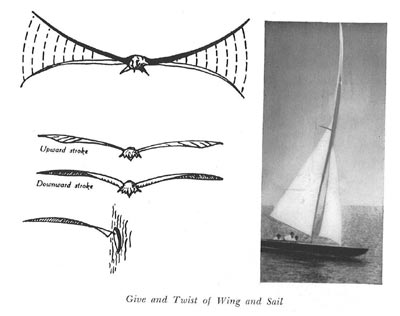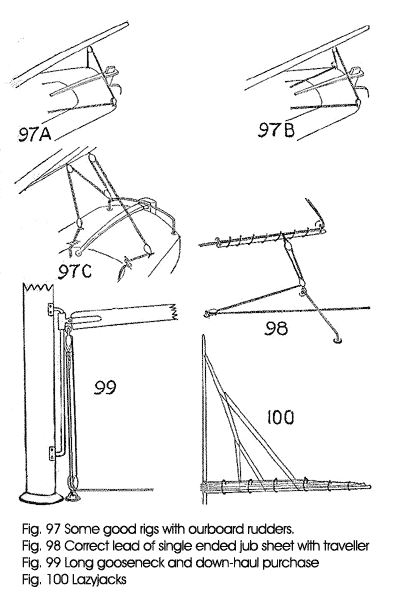Yacht Racing
The Aerodynamics of Sails and Racing Tactics
Fifth Edition, 1953
By Dr. Manfred Curry
Yachtsman’s Omnibus
Learning to Sail
Learning to Race
Learning to Cruise
By H.A. Calahan
Review by Peter
H. Vanderwaart
My father moved to smaller quarters. He sent me
a box of sailing books, many which were on our shelf when I
was a boy. My father learned to sail and race from these books.
I learned from him, and eventually I read the books myself.
As I looked through the worn volumes, I noted that some ideas
have been accepted, some have been discarded, some have simply
been left behind. And I learned something about myself: two
of these books were major influences on how I think about sailboats
and sailing, and the kind of sailor (or sailboat fanatic) I
am.
Manfred Curry brought engineering analysis of
racing sailboats into the public eye. I was familiar with Yacht
Racing when I was in elementary school, long before I had the
scientific or mathematical education necessary for any deep
understanding. I remember looking at the pictures of birds’
wings, wind tunnel tests, polar diagrams, smoke trails, and
race photos with great curiosity, and marveling at Curry’s
apparent ability to gain practical advantage from theoretical
insight.

(click to enlarge)
When Curry was writing in the first half of the 20th century,
there was great concern about the distribution of pressure and
“suction” at the various parts on a sail. In a modern
book, the discussion concerns laminar flow, stalled flow, and
the shedding of vortices. I suppose this is progress.
The sections on racing examine the aerodynamic interaction of
boats sailing in close company, and derive appropriate tactics
for common racing situations. These I experienced for myself crewing
for my father in our GP 14 dinghy. The practical importance of
the ‘safe leeward’ and ‘hopeless’ positions
were confirmed by experience. The photographs in this section
convey the excitement of racing and the wonderful workmanship
of the handmade boats of the early 20th century.
Sail racing has changed a lot since 1925. In the preface to the
fifth edition, Curry wrote, “In spite of experience gained
in about 1,400 regattas, I have been unable to improve on my racing
tactics.” The problems raised by wind shifts are absent
from Curry’s analysis, but are a major topic in any modern
treatment of sail racing tactics. I wonder if he excluded them
as “not tactical” or “not susceptible to analysis”,
or if he was actually unaware of them.
H. A. Calahan’s Yachtsman’s Omnibus is single volume
containing separate books on sailing, racing, and cruising. This
is a book with which I passed my winters, honing my skills, vanquishing
my competition, and, especially, setting off around the headland
and up the sound of my imagination. Calahan was a great personality
and a wonderful writer. Here is the opening paragraph of the chapter
on Sleep from Learning to Cruise:
“Most readers will probably contend that one doesn’t
need to learn to sleep; but on a boat, where all things are so
different, sleeping must be learned just as seamanship is learned.
There is an art to sleeping on board a boat. Sleep is a scarce
and precious commodity. No one should ever go on a cruise with
the idea of catching up on his sleep.”
His advice is commonsensical. He stresses competence, diligence
and planning. Of special interest to me was the chapter-by-chapter
discussion of different sailing rigs and their suitability for
cruising. In this he was open minded, but not afraid to declare
favorites. So well did I absorb his arguments, I carry his prejudices
to this day.

Illustration from Learning to Sail
Of course, all of his advice as to specific products and techniques
is obsolete, but his outlook is not, and never will be.
Calahan’s discussion of racing presents a contrast to Curry’s.
It is anecdotal rather than systematic, intuitive rather than
scientific. Still, Calahan was familiar with Curry’s work
and refers to it. Calahan does have a section on wind shifts,
and while Curry’s interest is around the buoys, Calahan
is more interested in distance racing.
It used to be said that you learn to ice skate in summer, and
to swim in winter. Learning occurs when the mind processes experience.
These books helped me process the experiences of small boat sailing,
and from them I learned attitudes that I still bring to sail boating.
|

